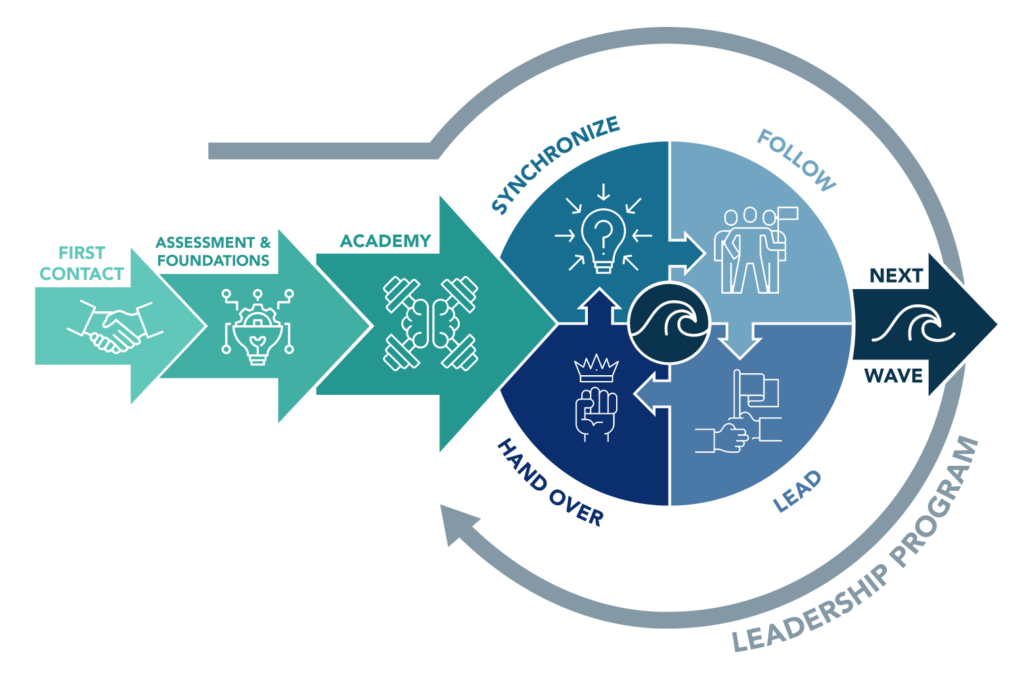This article is the second part of a series on a global transformation journey, led by Arie van Bennekum, co-author of the Agile Manifesto and Wemanity thought leader.
In the previous article, we found out about the first contact with the client, what were their current challenges and expectations. In this second part, we are going to dive into the very first step of a transformation: the assessment, along with the foundations (in this article).
Welcome back Arie! We’re glad you could join us for this second interview. To begin with, what’s the first thing you did to kick off the client’s transformation?
Arie: The very first thing we did, and what is recommended to do in a transformation, is an assessment: we look at the current situation to understand where the company stands and what it wants to become. We define a transformation roadmap together, where to start and where to go. Just like in sports: if someone wants us to help them become a good athlete, we need to know how fit they currently are, and what kind of athlete they want to be.
More specifically, we analysed their current organisation and assessed it based on 8 competencies, on a scale from one to five. You don’t want to over-prepare but you need to have a clear direction (ie. values to be achieved by the transformation) to know what to do. I always say that a coach makes you better in what you do, and a transformation makes you do different things.
For every step of the transformation journey, we followed the IATM (the Integrated Agile Transformation Model), a custom-made framework based on over 20 years of experience, to accelerate companies’ transformations through what we call “waves”.

How long does the assessment phase last? In this specific case, how much time was needed?
Arie: Most of the time, an assessment takes two weeks. It was the same case here.
Doing an assessment for an organization of 5000 people can take the same amount of time than for an organization of 500 – you understand that overdoing yourself has no use at one point. If you discern the culture, the delivery quality, the workload etc., then the numbers behind shouldn’t matter. One sprint and one value only, to clearly understand the client.
How many people were involved? How were they selected?
Arie: We interviewed about 40 people located across China and Czech Republic.
To select the people to interview, we studied the company’s organisational chart and with the client, we selected people from both the vertical and the horizontal structure in the organisation. We interviewed people from various management layers, and people from both staff and delivery teams.
How many Wemanity coaches were involved?
Arie: We were 5 people involved, however not everyone was full time. Because it included travel from our team to China, organizing visa and travelling to other locations as well, we chose to split up. We formed a multidisciplinary, agile, cross-skilled team in order to be independent on our topics: tech, corporate psychology, leadership and delivery, and of course translating an observation in a transformation activity, while focusing on clients’ value.
In details, how did you proceed to execute the assessment?
Arie: The first step, as I mentioned before, was to set up interviews: we talked to the people previously identified and involved in the transformation.
- We discussed with the managers in order to understand how they were working at the moment, what their documentation looked like, what their strategy was, their business objectives, values, practices, etc.
We start these interviews with very simple questions, such as “How do you receive your work, with whom do you collaborate, and what does it look like when finished?”. From there, we can go into areas like decision-making structures, silos, bureaucracy, and so on.
- On top of the interviews, we visited their teams on site and observed their way of working to fully understand our starting point. This GEMBA walk, as we call it, is essential. Words can often differ from the real situation.
- While we did the interviews and the work visits, we started setting up our agile space (an open room where people can come whenever they want and follow the process of the assessment, and later the transformation). In that room, we created 8 flip charts, each for one of the 8 competencies, where we listed anonymous observations and keywords that stood out from the interviews and visits.
- Little by little, the flip charts came to live and the different observations started complementing each other, which gave us an overall impression, as opposed to individual statements. This is the moment where the observations turn into transformation epics and stories.
This is what I love about this way of working. Everything is transparent, yet not too personal as there is no way to retrace who said what. You might think your client will hide things from you when assessing them; but through this approach, they actually tend to open up. Ultimately, they decide what they give.
“Transparency is the carrier of Agile”.
- Finally, we invested time in analysing the silos and struggles perceived to try to see how we can later break them down.
What did you deliver at the end of the assessment?
Arie: We reported to the client – in this case, to the group board – a restitution of our interviews and our daily visits with the teams, where we gave the outcome of what we saw, and the ranking of all the competences from 1 to 5.
We had the client’s involvement from day one, which allowed them to follow every step of the assessment easily. This helped them understand where they were situated, and whether they were scoring high or low.
Although the assessment phase is not about delivering concrete actions yet in the transformation process, we delivered a first set of recommendations to focus on. Those recommendations were actionable right away, even without our help. They help the organisation communicate on their current process and the next steps.
Right after the assessment comes the foundations, an essential part of setting up the first wave. Read about it here!












